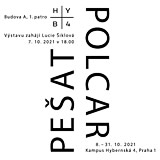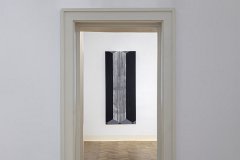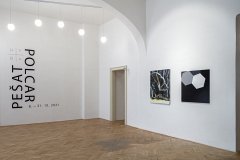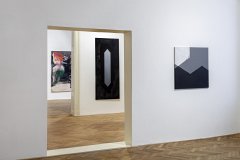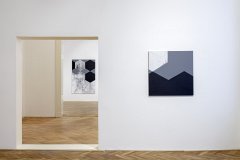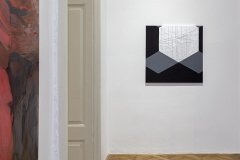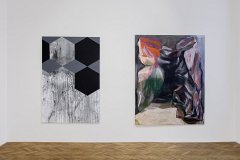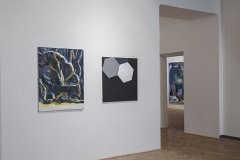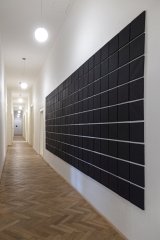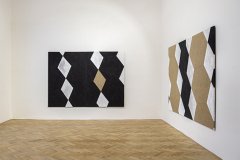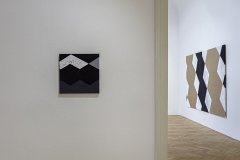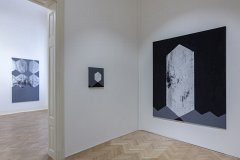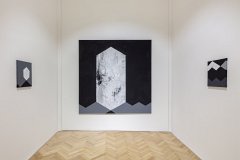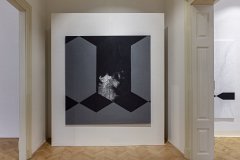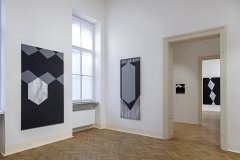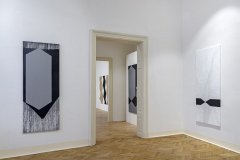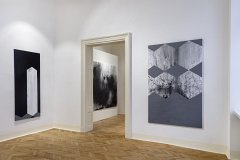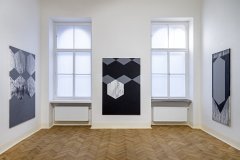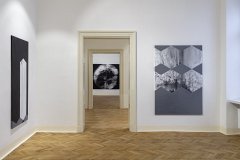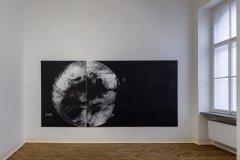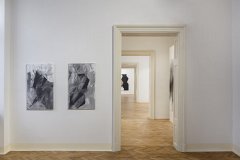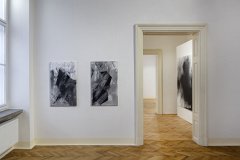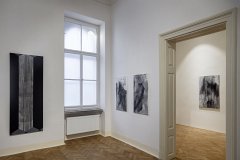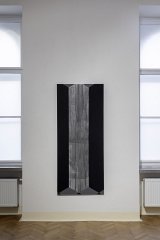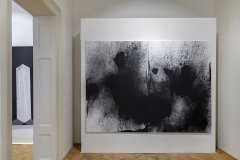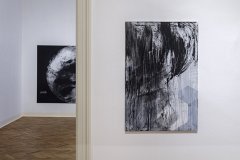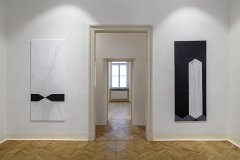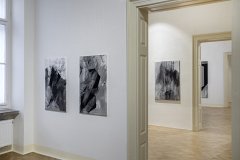PEŠAT–POLCAR
Kampus Hybernská 4, Praha
8.–31. 10. 2021
Photo: Ester Polcarová
Dialegomai
How to describe and explain the unpredictable connection between David Pešat and Tomáš Polcar?
There are denominations for confrontation and dialogue. We avoided these overused terms in the eponymous title but we can not omit them. At the first sight, there is a confrontation (from Latin frons, a forehead), thus a meeting face to face and mutual comparison, but also an encounter, which does not exclude a conflict. The two authors, the two completely different aesthetics, two completely different attitudes. The conceptual thinking and several hand-written positions at almost exclusively the monochromatic abstract compositions by Tomáš Polcar. As for David Pešat, hand-written fixed colourful expressive painting turning to its modernistic basis from the first half of the 20th century. Sown the seeds of severe collision. Clash! However, the collision is not happening; and a dialogue between two different kinds of painting is developing from the essence of itself. We should understand the term dialogue (from Greek dialegomai, converse, ponder) as personal inquiry and answering, thus the inner dialogue kept via means of creation when the both participants seek and find, on their own, the meaning, the truth or the way. And the personal way and seeking implemented via creation, they are the moments in which the pieces of art by both so different artists cross and get in touch with each other. At last impolemical, cultivating dialog of the two personal discussions taking place in the spaces of personalities and universalities, intellect, willful layer of psyche and the depth of collective unconscious.
The dialogue, even the guided one, is at least from real life and opposite to the prepared monologue it is based on the situation. It is natural and so unpredictable. Through deeply reflected life encounters David Pešat and Tomáš Polcar find the same partners for the dialogue; their inner conversations, externally differently presented, are connected to the base of humanity and in this way they are touching the coat of general being, in terms of an overstatement.
David Pešat (1980) graduated from the Academy of Fine Arts in 2007 in Jiří Sopko school of painting and he represents the generation of painters who do not deal with the question of painting as a current or, on the other hand, outdated medium. He paints. The reflection of modernist painting attitudes is highly present in his works. He extracts these attitudes in his manner to formulate personal and deeply psychological moments. He develops faceted cubistic views with the emphasis to the meaning; at another time figures without faces, malformed and tending to be amorphous, with a hint at some surreal foundation. He can work with the colour impressively. From a first point of view, his pictures hold out a face which is expressive, wild in colours or raw, on the other hand the face elaborately uses symbolic potential. Pešat thinks in speech of myths. He goes through a kind of psychoanalysis by means of his paintings. He touches the topics which are deeply personal and also collective. Sometimes he places himself in the position of a fighting titan when during painting he deals with this medium metaphorically as the Maker, bonding his thoughts into the matter. He works on the canvas as a sculptor with the material not in the meaning of layering of the colorful matter but in terms of holding, kneading and remaking of the displayed theme. He forms the amorphous basis into the characteristic biomophous, organic structures, which arouses the allusion of entrails. Miles apart from abstraction, raw epicer of metamorphosis to the bone, dealing with humanity, he immerses himself in primordium, he retells not only myths but also instincts.
Tomáš Polcar (1973) went through Hugo Demartini Sculpture Studio, Monumental Art Studio of Aleš Veselý and he graduated in 1998 in Studio of Intermedia Work of Milan Knížák at the Academy of Fine Arts. He represents such a generation which experienced the tied up era before November 1989, but also could entertain freely in the 90s of the last century. He thinks widely conceptually and he stabilized several characteristic hand-written positions in the course of time. As for painting he holds mostly at the scale of white, grey and black shades and he moves between them strictly geometrically and with an expressive expression. He treats the undercoat and the colour as materialistically meaningful and frequently, he makes monumental pictograms at plain compositions on jute, performed with soot black. From a different point of view, he paints elemental sensitive landscapes inspired by the countryside. He combines these different attitudes and something like a 3D effect emerges from these pictures, something like a view over the borders of geometry to another dimension. In the case of the art of sculpture, he uses manually mixed concrete and again he applies the meaningfulness of the material and shapes. He does not employ probes into his own mind, although he finally touches himself with Jung's emphasis rather than Freud's. In the long term, he develops several thematic, open courses, respectively series, where in the beginning there is an encounter of a display (resonance, cyclicity, atomic structure). A mind way initializes here and he again makes it visible and closes it to the form of a picture and a sculpture. Rhythm, repetition, web. Mistake. Life. Growth. Collapse. Once as a bee breeder he was inspired by a honeycomb hexagon, the bearer of symbolic meanings mainly as a perfect, harmonic structure. On the way to the territory of harmony, the hexagon is for him a signal and an anchor.
Lucie Šiklová, 2021
